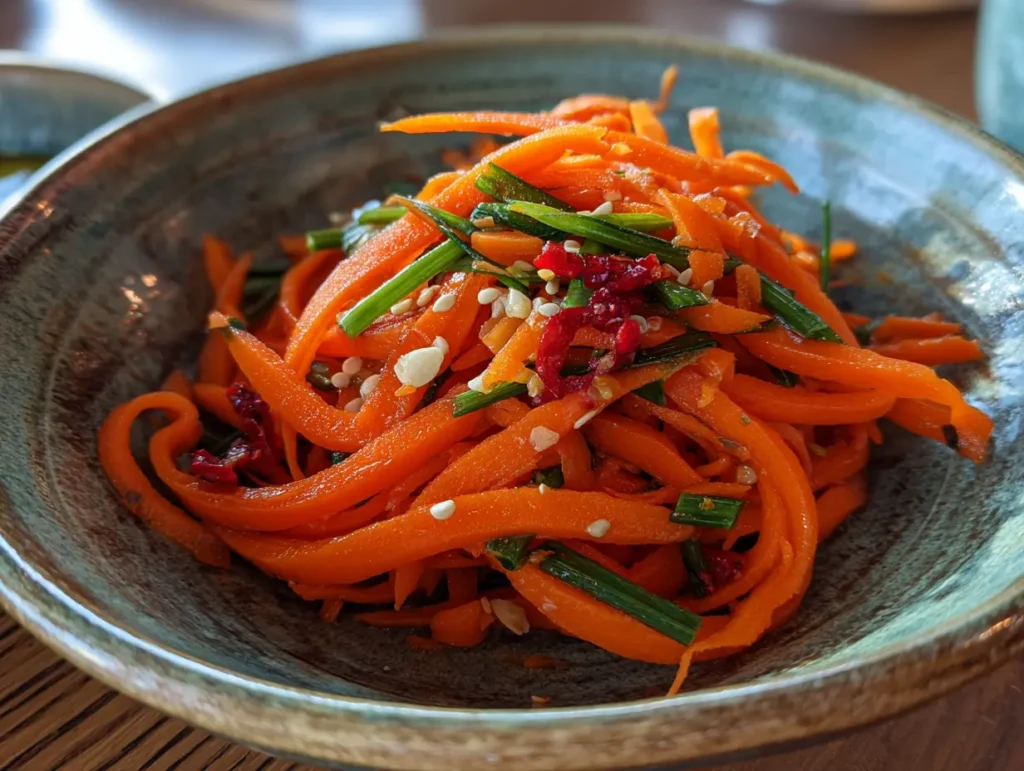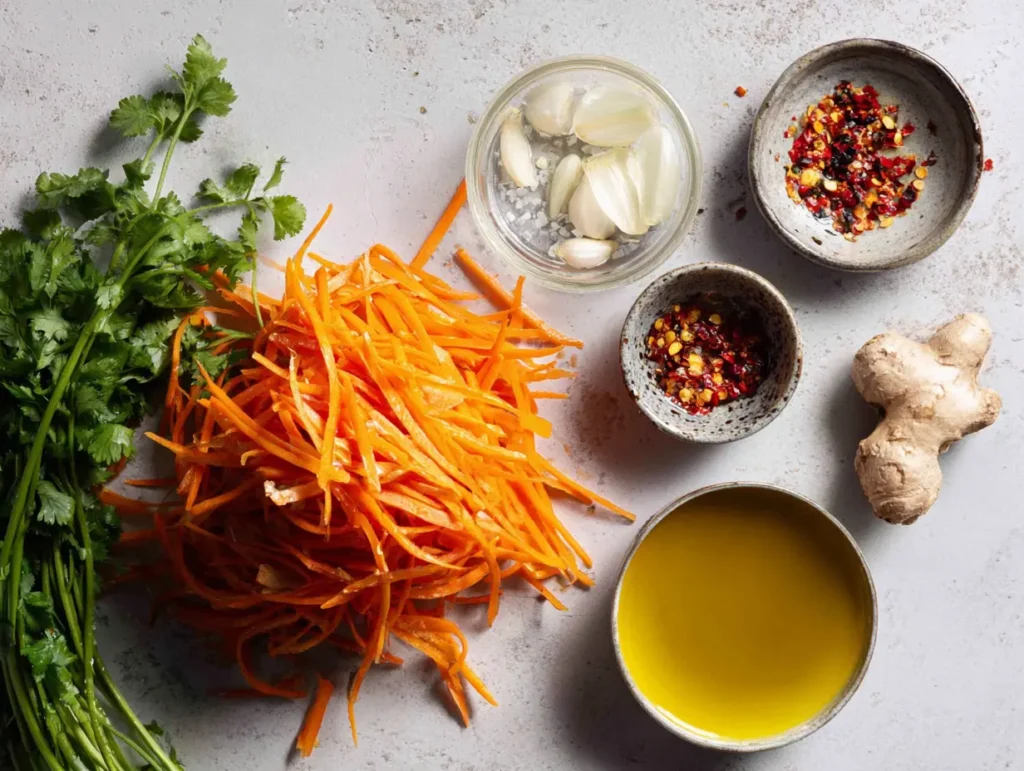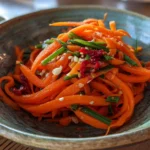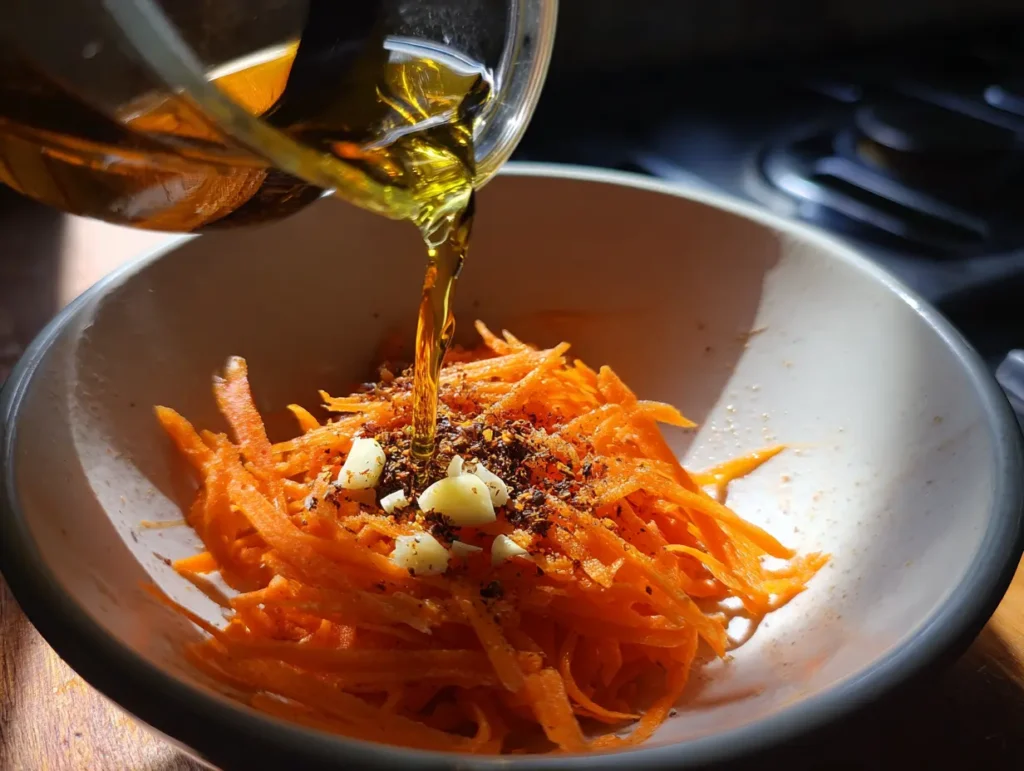Introduction to the Korean Carrot Salad Recipe
If you’re looking for a bold, flavorful side dish that’s crunchy, tangy, spicy, and totally addictive, the Korean carrot salad recipe is your new best friend. Despite its name, this vibrant salad isn’t traditionally Korean—instead, it’s a beloved creation of the Korean diaspora in Russia. Loaded with garlic, spices, and a vinegar punch, it’s become a global sensation.
This article will walk you through everything you need to know about this delicious Korean carrot salad recipe, including its unique origin, step-by-step prep, health benefits, and creative serving ideas. Whether you’re a seasoned foodie or just trying something new, you’ll love the balance of crunch, heat, and tang in this dish.
Looking for inspiration? Try our Zepbound Natural Recipe for a healthy kickstart alongside this vibrant salad.
Now let’s dive deep into the origins and popularity of the Korean carrot salad recipe.
Table of content
Table of Contents

Introduction to Korean Carrot Salad Recipe
What Makes This Salad So Popular Globally
The Korean carrot salad recipe has taken kitchens around the world by storm—not because it’s authentically Korean, but because it tastes so good, it doesn’t need to be. Born from the creativity of Korean immigrants in the former Soviet Union, this dish became a pantry staple in households across Eastern Europe, Central Asia, and beyond.
What sets it apart is the depth of flavor: fresh, raw carrots sliced thinly, soaked in a spicy, garlicky dressing of vinegar, oil, coriander, and red pepper flakes. The result? A salad that hits every note—sweet, spicy, tangy, and savory all at once.
It’s no surprise this Korean carrot salad recipe has spread through food blogs, TikTok trends, and health food circles. It’s simple to prepare, lasts in the fridge, and pairs perfectly with everything from grilled meats to rice bowls.
Why It’s Not Actually Korean (Origins and Russian-Korean Fusion)
Despite the name, the traditional Korean carrot salad recipe doesn’t come from Korea. It’s a culinary invention by Koryo-saram, ethnic Koreans who lived in Russia and Central Asia. These communities adapted local ingredients and spices to create dishes that honored their roots while embracing their new homes.
Without access to napa cabbage (for traditional kimchi), carrots became the go-to substitute. They seasoned it heavily to replicate the bold flavors of Korean cuisine. Thus, the spicy, vinegary Korean carrot salad recipe was born—a testament to resilience, fusion, and flavor.
This backstory gives the salad much more meaning than just another trendy side dish—it represents cultural survival and culinary innovation.
Ingredients You’ll Need

Essential Ingredients for Authentic Taste
The heart of any Korean carrot salad recipe lies in its bold yet balanced combination of ingredients. While the preparation is simple, every component plays a key role in creating that addictive flavor. To make the most authentic version of this Korean carrot salad recipe, here’s what you’ll need:
| Ingredient | Purpose in the Salad |
|---|---|
| Fresh carrots | Main base—sweet, crunchy, and vibrant |
| Garlic | Adds bold pungency and depth |
| Vegetable oil | Carries flavor and slightly softens carrots |
| Vinegar (see Part 4) | Delivers the signature tanginess |
| Sugar | Balances acidity with a touch of sweetness |
| Salt | Enhances all other flavors |
| Ground coriander | Offers warmth and slight citrusy notes |
| Red pepper flakes | Brings the heat that defines the salad |
| Optional: Soy sauce, sesame seeds | For extra umami and crunch |
To prepare a traditional Korean carrot salad recipe, julienne the carrots finely (manual or mandoline), then massage them gently with salt before dressing them with heated oil and seasonings. This process unlocks the carrots’ natural juices and melds all the flavors beautifully.
Substitutions and Variations Based on Diet (Vegan, Gluten-Free)
This Korean carrot salad recipe is naturally vegan and gluten-free, but you can still switch things up based on your dietary preferences or what’s available in your pantry. For example:
- Oil substitutions: Sunflower oil or avocado oil can be used instead of vegetable oil.
- Low-sugar: Replace sugar with stevia or omit entirely for a sharper taste.
- Spice levels: Adjust the red pepper flakes based on your heat tolerance.
- Gluten-free soy sauce: Use tamari or coconut aminos if you add soy sauce for umami.
These tweaks let you personalize the Korean carrot salad recipe while keeping its iconic flavor intact.
Discover great ideas like this Japanese Pink Salt Recipe for a unique sidekick to your salad prep or detox day.
Step-by-Step Guide to Making Korean Carrot Salad
Print
Korean Carrot Salad Recipe
- Total Time: 15 min
- Yield: 4 servings
Description
A bold and tangy Korean carrot salad recipe packed with garlic, vinegar, and spices. This easy-to-make side dish is crunchy, spicy, and bursting with flavor. A fusion dish with Russian-Korean roots known as “Morkovcha.”
Ingredients
- 4 large carrots, julienned
- 2 garlic cloves, minced
- 1/4 cup vegetable oil
- 1 tbsp white vinegar (or apple cider vinegar)
- 1 tsp red pepper flakes
- 1/2 tsp ground coriander
- 1 tsp sugar
- 1/2 tsp salt
Instructions
Salt the carrots and let sit 20 mins
Heat oil in pan, add garlic, spices
Pour hot oil mixture over carrots
Add vinegar, sugar, mix well
Chill and marinate 4+ hours
- Prep Time: 10 minutes
- Cook Time: 5 minutes
- Category: Weight Loss Meals
- Method: marinating
- Cuisine: Korean Fusion
How to Julienne Carrots Perfectly
The key to a great Korean carrot salad recipe is texture—and that starts with julienning your carrots just right. Thin, even carrot strips allow the seasoning to cling beautifully while still offering that satisfying crunch.
Here’s how to do it:
- By hand: Peel the carrots, cut into 2–3″ sections, then slice thin planks. Stack and slice again into matchsticks.
- Using a mandoline: Choose the julienne blade setting and glide peeled carrots lengthwise.
- Food processor: If you’re in a rush, a shredding disk attachment can help—just don’t overprocess or the carrots will lose their crisp texture.
For the perfect Korean carrot salad recipe, aim for sticks about 1/8 inch thick and 2–3 inches long. This helps them absorb all that garlicky, vinegary magic without becoming soggy.
Cooking, Seasoning, and Marinating Tips
Now let’s walk through the full prep process for a classic Korean carrot salad recipe, step by step:
- Salt and toss your julienned carrots lightly. Let them sit for 20 minutes to soften slightly.
- In a small pan, heat vegetable oil until just hot—don’t let it smoke.
- Add crushed garlic to the carrots, followed by red pepper flakes, ground coriander, and a dash of sugar.
- Pour the hot oil directly over the seasonings on top of the carrots. It sizzles and brings out bold aromas.
- Add vinegar and mix everything thoroughly.
- Marinate in the fridge for at least 3–4 hours, ideally overnight. The longer it sits, the deeper the flavor.
Pro tip: Stir the salad halfway through marinating to evenly coat all the carrot strips. And don’t skip the oil infusion step—it’s what gives this Korean carrot salad recipe its rich, aromatic taste.
If you’re feeling creative, toss in some sesame seeds, scallions, or a splash of soy sauce before serving. That extra umami boost pairs beautifully with grilled proteins or rice dishes.
Check out more gut-friendly ideas like our Zepbound Natural Recipe to add to your clean-eating rotation.

What Vinegar to Use for Korean Carrot Salad
Apple Cider Vinegar vs. White Vinegar vs. Rice Vinegar
Choosing the right vinegar can make or break your Korean carrot salad recipe. Since this salad gets its signature tang from the vinegar, it’s important to know what each option brings to the table.
Here’s a quick breakdown of common choices:
| Vinegar Type | Flavor Profile | Best For |
|---|---|---|
| White Vinegar | Sharp, acidic, clean | Classic, traditional flavor |
| Apple Cider Vinegar | Milder, fruity undertone | Adds depth and pairs well with garlic |
| Rice Vinegar | Slightly sweet, mild | Softer, Asian-inspired version |
- White vinegar is the most commonly used in a traditional Korean carrot salad recipe, especially in Eastern European kitchens. Its acidity is strong and direct, which cuts through the carrots’ sweetness beautifully.
- Apple cider vinegar offers a bit more complexity and is a great choice if you’re aiming for a slightly softer tang.
- Rice vinegar is the mildest and is ideal for those who want a gentler flavor with less bite.
No matter which one you choose, the vinegar should be of good quality, as it’s one of the primary flavor drivers in the Korean carrot salad recipe.
How Vinegar Affects the Taste and Texture
Vinegar doesn’t just add flavor—it also impacts the salad’s texture and shelf life.
- The acidity in vinegar helps soften the carrots slightly without cooking them, giving you that ideal bite.
- It also acts as a natural preservative, making this salad last for several days in the fridge.
- The tangy kick enhances the spices and aromatics, helping them shine through with every bite.
In a well-balanced Korean carrot salad recipe, vinegar is more than an ingredient—it’s the flavor backbone. Use it wisely, and you’ll get that addictively zesty finish every time.
Don’t miss our Japanese Pink Salt Recipe for another bold, wellness-friendly flavor upgrade.
Health Benefits of Raw Carrot Salad
Carrots and Beta-Carotene: Good for Eyes, Skin, and Heart
One of the standout reasons the Korean carrot salad recipe has gained so much love is because it’s not just flavorful—it’s packed with nutrients too. The primary ingredient, raw carrots, is a nutritional powerhouse. They’re rich in beta-carotene, which converts to vitamin A in the body and supports eye health, immune function, and glowing skin.
A single serving of this Korean carrot salad recipe can deliver over 100% of your daily vitamin A requirement. That means you’re helping your vision, reducing inflammation, and possibly lowering your risk of heart disease—all while enjoying a spicy, tangy bite.
Carrots are also high in fiber, which supports digestion and helps you feel fuller longer, making this salad a smart option for those watching their weight.
Benefits of Garlic, Vinegar, and Spices in This Recipe
Let’s not forget the supporting cast in the Korean carrot salad recipe—garlic, vinegar, and red pepper flakes. These aren’t just flavor boosters—they offer real health benefits:
- Garlic contains allicin, a natural compound known for its anti-inflammatory and antibacterial properties. It may help reduce blood pressure and boost immunity.
- Vinegar, especially apple cider vinegar, is associated with improved blood sugar control and digestion. It also helps curb appetite by promoting satiety.
- Spices like coriander and chili flakes may aid metabolism and offer antioxidant protection.
Together, these ingredients make the Korean carrot salad recipe not only a vibrant addition to your plate but also a powerful ally for your overall wellness routine.
If you’re into food with benefits, don’t miss our Japanese Pink Salt Recipe—a flavorful option that pairs perfectly with healthy habits.
FAQs
What vinegar to use for Korean carrot salad?
For an authentic Korean carrot salad recipe, the most commonly used vinegar is white distilled vinegar due to its sharp, clean acidity. However, apple cider vinegar is a great alternative if you prefer a fruitier, softer tang. Some modern versions of the salad also use rice vinegar for a milder, slightly sweet flavor. Ultimately, the best vinegar is one that balances well with the garlic and spices used in the recipe.
What is a Korean carrot salad called?
Although widely known as the Korean carrot salad recipe, the traditional name for this dish is “Morkovcha” or “Morkov po-koreyski”, which translates to “carrots Korean-style.” It was created by Korean communities in Russia (the Koryo-saram) who adapted local ingredients when traditional kimchi was not available. So despite its name, this dish is a unique fusion of Russian and Korean cuisines.
What does raw carrot salad do for you?
Eating a raw carrot salad, like the one in the Korean carrot salad recipe, provides several health benefits. Carrots are packed with beta-carotene, which boosts vision and skin health. The fiber aids in digestion, and the garlic and vinegar used in the salad can help support immunity and gut health. It’s a nutrient-dense side dish that fits well into wellness-focused meals.
How long does carrot salad last?
When stored properly in an airtight container in the refrigerator, the Korean carrot salad recipe can last up to 5–7 days. In fact, the flavor often improves after a day or two of marinating. However, always check for off smells or sliminess before serving leftovers. For best results, stir the salad before each use to redistribute the dressing evenly.
Conclusion
If you’re looking for a simple yet flavor-packed side, the Korean carrot salad recipe is the perfect blend of sweet, spicy, and tangy. Whether you’re a fan of bold flavors or want a health-boosting dish that pairs well with almost anything, this salad delivers.
Its origins tell a story of cultural fusion, and its ingredients support immunity, digestion, and overall wellness. The best part? It’s incredibly easy to customize with your favorite spices, vinegars, and toppings.
So grab some fresh carrots, prep your julienne game, and bring this iconic dish to life. Once you try the Korean carrot salad recipe, you’ll be adding it to your rotation again and again.
Don’t miss our Japanese Pink Salt Recipe for another tangy, health-forward flavor to complement your meals.
